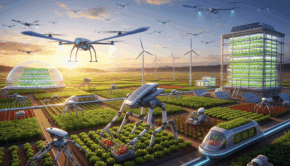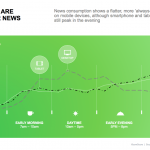Technology in the Workplace: The Digital Future Of Work
Technology is redefining the modern workplace and business operations in a huge way. The impact of disparate technologies and solutions as opposed to specific dedicated applications has been considerable. We are cruising into an inevitable future where digital technologies are a core component of not only the way we work, but also an integral part of our day-to-day lifestyles.
As digital technologies continue to broaden their reach, redefining organizations and the very nature of how they work, let us take a look at prominent trends at the forefront. Those that are dynamically shaping the future of the way we work.
A Changing Workforce
As the global workforce is increasingly turning young, especially with the influx of millennials, their dynamic styles of working and management is making its mark on organizations. This is in addition to the increasing digitization and proliferation of technology that the existing (aging) workforce is unable to keep pace with.
Digital technologies have redefined everything that were conventionally done in the past, including the routine tasks at work and home. This trend is becoming even more prevalent as the current state-of-the-art technologies evolve and morph to become intertwined with our lives.
Working Remotely
The accessibility and connectivity provided by digital tools is turning location or geography irrelevant. Talent and capabilities are valued the most, thanks to technology.
The ages old concept of having central workplaces was to converge all of the organization’s resources to collaborate and achieve a collective goal. It’s not impossible to achieve this by leveraging a purely digital or a balanced hybrid approach.
No wonder that these developments has given rise to the trend of telecommuting and also inevitably the aspect of work-life balance as a top priority for present-day employees. Progressive enterprises have taken cognizance of this trend, and have dealt with it in a substantial manner. Tangible benefits include significant cost savings in addition to a considerable boost in productivity, work satisfaction and improved collaboration among employees.
Increased Adoption of AI
Repetitive, exhaustive and time-consuming tasks are one of the most prevalent factors that create fatigue and unrest amongst employees. If not properly managed, it can also introduce a layer of errors and omissions within work. In its current state, automation can to a large extent undertake most such tasks and free up resources, so that the organization can focus on other critical business functions. Rather than being mired in repetitive and fatigue-inducing operations on a daily basis, this ensures that their core expertise is well utilized.
In the future, the cognitive capabilities of Artificial Intelligence are set to bring greater precision as well as efficiencies. AI will become pivotal and of crucial importance for in-house operations and customer-facing challenges.
Smart Workplaces
Differentiating themselves from the competition is the veritable key for any business in the market. But efficiency and productivity (of employees and infrastructure), which directly impact the fortunes of an organization, is often at the receiving end due to mismanagement of resources and communication.
Of late, IoT technology, as well as other IT based solutions like communication tools have been quite effective in eradicating such bottlenecks. Technology is thus driving greater fluidity in regular operations and unlocking the potential for innovations in a business organization.
Employee Empowerment
The ultimate objective of any business or organization is to achieve quantifiable end results. Today’s businesses acknowledge the fact that individuals are more comfortable with disparate technologies, solutions, and modes of communication and collaboration.
Aside from a virtual workplace, employees are also being increasingly allowed to utilize their own devices as opposed to company-provided ones. This makes it easier for an individual to manage work and personal life using a single device.
The concept of BYOD (Bring Your Own Device) and maybe eventually BYOA (Bring Your Own Application) will put the onus on system professionals. Instead of merely ensuring the uptime of the network environment and connected devices, they will have to understand the various dynamic modules and ensure zero leakages or associated vulnerabilities.
Security Demands
The burgeoning IT infrastructure and widening network coverage is increasing the perimeter of resources that needs to be protected. A modern business enterprise has to not only needs to ensure that it’s network comprising of numerous individual nodes are protected both as a singular and as a collective entity, but also defend its core infrastructure from external and internal attacks.
A cyber attacker can utilize any of these numerous access points to penetrate the network and wreck havoc. In time, enterprises will have to focus more on data and network security issues to protect their business fortunes and their strides in digital transformation.
Improved Communication
Video is increasingly at the forefront of facilitating seamless communication that at times, exceeds our expectations. In addition, the advances in Augmented and/or Virtual Reality give us a strong indication of how our workplaces are likely to evolve in the future. Critical resources might no longer need to be physically present for business meetings and decision making processes where their inputs are required.
Project-based Outsourcing
Organizations regularly face constraints in terms of talent and resources, that create room for inconsistency and gives rise to friction in their operations. Consequently, many are increasingly adopting project-based outsourcing by way of hiring contractors and MSPs (Managed Service Providers) to execute work commitments – both short-term and long-term. This trend is also being driven by the increased demand for specialization, cloud infrastructure, and the need to increase revenues while cutting down on cost overheads.
Such a modern focussed approach enables businesses to scale or down/right-size their operations as and when they need. This comes with greater flexibility while decreasing the workload of its in-house resources and also adds to its operational efficiency. However, this demands better management of the overall resource utilization as well as synchronization of all across-the-board processes.
Conclusion
With exploding opportunities in digital technologies and as their adoption across various industries increases, business organizations are being equipped to be able to adapt and utilize futuristic solutions. All in their best interests to gain (and maintain) a veritable edge against competition. This scenario also enables them to increase productivity with relatively less incremental expenditure on resources, manpower and infrastructure.
It may be safely assumed that the future seems to be bright for those organizations that take stock of the ongoing trends and adapt themselves (with some help from your friendly IT Support provider in Austin, of course!) accordingly.
Author Bio:

David Grubb
President of Gravity Systems has over 24 years’ experience in business technology. With a career spanning several industries and leadership roles, he is a regular advisor to leading research organizations. Finding innovative solutions to increasingly complex business challenges is a core strength and area of expertise for David.



















